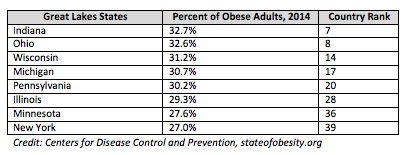By AMELIA HAVANEC
Capital News Service
LANSING – New data from the Centers for Disease Control and Prevention (CDC) show that the high rate of obese adults nationally is finally steadying from an upward climb since the 1990s, and Michigan is no exception.
The portion of Michigan adults estimated to be obese in 2014 was 30.7 percent, the lowest it’s been since 2010.

Sanilac, Saginaw and Chippewa counties are the most obese, while Ottawa, Washtenaw and Oakland are the least, according to the CDC.
“Our most recent Community Health Needs Assessment, compiled earlier this year, identifies obesity as a significant health issue for the area we serve surrounding Ludington,” said Bill Kerans, marketing coordinator of Spectrum Health Medical Group in Ludington. “Two thirds – 67.6 percent – of adults in our service area are considered overweight (33.5 percent) or obese (34.1 percent) based on their BMI. So our adult obesity rate is higher than the state figure of 30.7 percent.”
“In a more rural environment like we mostly are in Michigan, aside from a few large cities, we have to drive everywhere we go,” said Ranelle Brew, an assistant professor in the public health program at Grand Valley State University. “We’re sort of hampered not to do this natural exercise” of walking.
Although the obesity rates – and pounds – dropped last year, Michigan puts up high numbers compared to the rest of the country, according to the CDC.
The state ranks 17th in obesity rates and 13th and 12th in the number of adults with obesity-related issues, such as hypertension and physical inactivity, respectively.

“We’ve seen stabilizations of these rates but they are bad enough already,” said May Darwish-Yassine, chief program officer of the Michigan Public Health Institute in Okemos.
The data are based on telephone surveys by state health departments in which adults report their weight and height.
In the Upper Peninsula, “even though people have access to a lot of outdoor activities, some of them don’t know why they need to be physically active,” said Yuba Gautam, an assistant professor of community health at Northern Michigan University. “Or they can’t afford” the outdoor recreational activities available to them “and that creates a big barrier for us.”
Obesity is a condition in which the body stores excess fat. Its most common indicator is Body Mass Index (BMI), which compares the ratio between a person’s height and weight. People are classified as obese when their BMI is 30 or greater.
Obesity often is the prelude to an array of medical problems, such as heart disease, stroke and respiratory problems – which make up three of the five leading causes of preventable deaths in the U.S., according to a separate report by the CDC.
“It used to be that society blames the person – either it’s behavioral or it’s an eating pattern,” Darwish-Yassine said, “when in reality there are a lot of social determinants that play into this: the environment, availability, a person’s health priorities, poverty issues, etc.”
“There are a lot of things that need to happen,” she added. “We can’t just put out a brochure and say, ‘Eat healthy and exercise three times a week.’ So programs have been initiated.”
In 2011, the Michigan Public Health Institute prepared a 10-year plan to reduce obesity rates by increasing the number and quality of programs that support physical activity and healthy eating throughout the state.
The plan’s goal is to lower obesity rates to 30.5 percent by 2020. The CDC’s data shows that the state is very close at 30.7 percent.
But if the obesity prevalence continues to rise, then the state is projected to spend approximately $12.5 billion on obesity-attributable health care costs by 2018, according to a collaborative report by the United Health Foundation, the American Public Health Association and Partnership for Prevention.
The state is involved in three other programs that create awareness and motivational workshops to help people adopt healthier practices. Although many risk factors contribute to obesity, changes in diet, physical activity and exercise. can counteract them through the programs.
Michigan Personal Action Toward Health (PATH), for instance, offers free workshops to help adults with long-term health problems, including obesity. The MI Healthier Tomorrow program allows people to receive bi-monthly motivational tips and take a pledge to reach their health goals.
For more information, visit the Department of Health and Human Services website at www.michigan.gov/mdhhs.
Spartan Newsroom - News and information from student journalists at the Michigan State University School of Journalism
Spartan Newsroom (https://news.jrn.msu.edu/2015/10/finally-obesity-rates-take-hike-downward/)